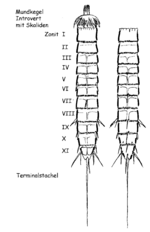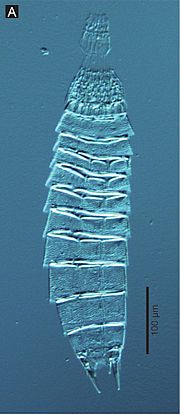Kinorhyncha facts for kids
Quick facts for kids Kinorhynchs |
|
|---|---|
 |
|
| Scientific classification | |
| Kingdom: | |
| Superphylum: | |
| Phylum: |
Kinorhyncha
Reinhard, 1887
|
| Orders | |
|
Cyclorhagida |
|
Kinorhynchs are tiny sea creatures, usually less than 1 millimeter long. They are a type of invertebrate, which means they don't have a backbone. You can find them living in the mud or sand all over the ocean, from shallow areas to very deep parts. People sometimes call them "mud dragons" because of their spiky look!
Scientists know about 150 different kinds, or species, of kinorhynchs. These small animals eat tiny plants called diatoms or other natural bits found in the mud. What they eat depends on the specific species.
Contents
About Kinorhynchs
Kinorhynchs are animals that have a body made of different parts, like segments. They don't have any legs or fins. Their body is divided into three main sections: a head, a neck, and a longer part called the trunk. The trunk has eleven separate segments.
These creatures don't have tiny hairs called cilia on their outside. Instead, they have many spines along their body. They also have up to seven rings of spines around their head.
How Kinorhynchs Move
Kinorhynchs use their spines to move around. They can pull their head back into their body. Then, they push their head forward and use the spines to grip the mud or sand. After gripping, they pull the rest of their body forward. It's a bit like how a worm moves!
Body Structure
The outside of a kinorhynch's body is covered by a thin but tough layer called a cuticle. This layer is like a protective skin. As the kinorhynch grows, it sheds this tough outer layer several times. This process is called molting.
The spines on their body are hollow and also covered by this tough cuticle. Their head can completely pull back into their body. When it does, a set of special plates on their neck covers and protects it.
Nervous System and Senses
Kinorhynchs have a simple nervous system. It includes a main nerve cord that runs along the bottom of their body. In each body segment, there is a small group of nerve cells called a ganglion. They also have a ring of nerves around their throat area. This setup is common for many invertebrates.
Some kinorhynch species have simple eye-spots on their head. These eye-spots can sense light. All kinorhynchs also have tiny bristles on their body. These bristles act like touch sensors, helping them feel what's around them.
Reproduction and Life Cycle
Kinorhynchs have two sexes, male and female, but they look very similar. They have a pair of reproductive organs, called gonads, in the middle part of their trunk. These organs open up through small holes in their last body segment.
In most species, the male's sperm tube has small spiny parts. These spines likely help them during mating. After mating, the young kinorhynchs, called larvae, are free-living. This means they can move around on their own.
Classification
Scientists group kinorhynchs with other similar animals. Their closest relatives might be two other groups of tiny sea creatures: Loricifera and Priapulida. Together, these three groups are sometimes called the Scalidophora.
Here are the main groups within the Kinorhyncha phylum:
- Order Cyclorhagida
- Order Homalorhagida
See also
 In Spanish: Kinorhyncha para niños
In Spanish: Kinorhyncha para niños


